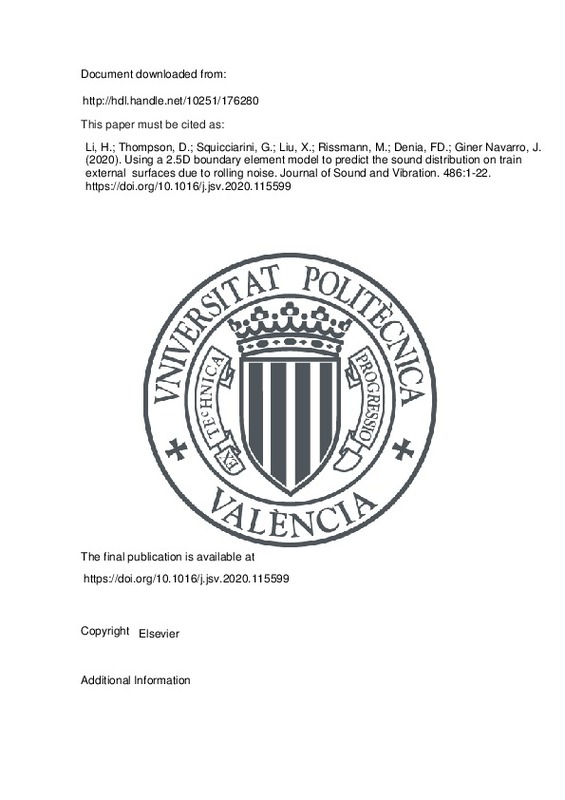JavaScript is disabled for your browser. Some features of this site may not work without it.
Buscar en RiuNet
Listar
Mi cuenta
Estadísticas
Ayuda RiuNet
Admin. UPV
Using a 2.5D boundary element model to predict the sound distribution on train external surfaces due to rolling noise
Mostrar el registro sencillo del ítem
Ficheros en el ítem
| dc.contributor.author | Li, Hui
|
es_ES |
| dc.contributor.author | Thompson, David
|
es_ES |
| dc.contributor.author | Squicciarini, Giacomo
|
es_ES |
| dc.contributor.author | Liu, Xiaowan
|
es_ES |
| dc.contributor.author | Rissmann, Martin
|
es_ES |
| dc.contributor.author | Denia, Francisco D.
|
es_ES |
| dc.contributor.author | Giner Navarro, Juan
|
es_ES |
| dc.date.accessioned | 2021-11-05T14:07:19Z | |
| dc.date.available | 2021-11-05T14:07:19Z | |
| dc.date.issued | 2020-11-10 | es_ES |
| dc.identifier.issn | 0022-460X | es_ES |
| dc.identifier.uri | http://hdl.handle.net/10251/176280 | |
| dc.description.abstract | [EN] In order to be able to predict train interior noise, it is first important to calculate the external sound pressure distribution on the floor, sidewalls and roof. This can then be combined with the transmission loss of the train panels to determine the interior noise. Traditional techniques such as the finite element and boundary element (FE/BE) methods in three dimensions (3D) can achieve this result but are computationally very expensive. In this paper, a wavenumber-domain boundary element (2.5D BE) approach is instead adopted to predict the propagation of rolling noise from the wheels, rails and sleepers to the train external surfaces. In the 2.5D models, only the cross-section of the vehicle is represented by using boundary elements, while the third direction is considered in terms of a spectrum of wavenumbers. The rail is treated directly in the wavenumber domain but, to include the wheel, a method of representing point sources in a 2.5D approach is developed. An inverse Fourier transform is applied to obtain the spatial distribution of the sound pressure on the train surfaces. The validity of this approach has been verified by comparison with experimental data. The 2.5D BE method was first used to predict the sound distribution on a 1:5 scale train surfaces due to a point source below the vehicle, and later it was used to predict the sound pressure on a full-scale metro vehicle due to a loudspeaker. Comparisons of predictions with measurements on the scale model and on the metro vehicle showed good agreements. For a point source below the vehicle, the sound pressure levels on the train floor were found to be around 20 dB higher than on the sides, and the sound pressure on the train roof was negligible. The 2.5D BE method was also used to predict the sound pressure on the metro vehicle surfaces in running operation, in which the predicted sound pressure levels on the train external surfaces agreed with measurements to within 3 dB and similar trends were found in terms of spectra and longitudinal distribution of pressure. | es_ES |
| dc.description.sponsorship | The work presented in this paper has received funding from China Scholarship Council and the Shift2Rail Joint Undertaking under the European Union's Horizon 2020 research and innovation programme (grant agreement no. 777564). The contents of this publication only reflect the authors' view and the Joint Undertaking is not responsible for any use that may be made of the information contained in the paper. The authors would also like to thank Dr. Hongseok Jeong for his assistance in the laboratory measurements and Metro de Madrid for assistance in the field tests. The authors are grateful to Dr. Xianying Zhang for providing the measured vibration of the 1:5 scale rail. All data published in this paper are openly available from the University of Southampton repository at 10.5258/SOTON/D1483 | es_ES |
| dc.language | Inglés | es_ES |
| dc.publisher | Elsevier | es_ES |
| dc.relation.ispartof | Journal of Sound and Vibration | es_ES |
| dc.rights | Reserva de todos los derechos | es_ES |
| dc.subject | 2.5D method | es_ES |
| dc.subject | Boundary element model | es_ES |
| dc.subject | Train external surfaces | es_ES |
| dc.subject | Rolling noise | es_ES |
| dc.subject.classification | INGENIERIA MECANICA | es_ES |
| dc.title | Using a 2.5D boundary element model to predict the sound distribution on train external surfaces due to rolling noise | es_ES |
| dc.type | Artículo | es_ES |
| dc.identifier.doi | 10.1016/j.jsv.2020.115599 | es_ES |
| dc.relation.projectID | info:eu-repo/grantAgreement/EC/H2020/777564/EU/Innovative RUNning gear soluTiOns for new dependable, sustainable, intelligent and comfortable RAIL vehicles/ | es_ES |
| dc.rights.accessRights | Abierto | es_ES |
| dc.contributor.affiliation | Universitat Politècnica de València. Departamento de Ingeniería Mecánica y de Materiales - Departament d'Enginyeria Mecànica i de Materials | es_ES |
| dc.description.bibliographicCitation | Li, H.; Thompson, D.; Squicciarini, G.; Liu, X.; Rissmann, M.; Denia, FD.; Giner Navarro, J. (2020). Using a 2.5D boundary element model to predict the sound distribution on train external surfaces due to rolling noise. Journal of Sound and Vibration. 486:1-22. https://doi.org/10.1016/j.jsv.2020.115599 | es_ES |
| dc.description.accrualMethod | S | es_ES |
| dc.relation.publisherversion | https://doi.org/10.1016/j.jsv.2020.115599 | es_ES |
| dc.description.upvformatpinicio | 1 | es_ES |
| dc.description.upvformatpfin | 22 | es_ES |
| dc.type.version | info:eu-repo/semantics/publishedVersion | es_ES |
| dc.description.volume | 486 | es_ES |
| dc.relation.pasarela | S\415503 | es_ES |
| dc.contributor.funder | China Scholarship Council | es_ES |
| dc.contributor.funder | SHIFT2RAIL JOINT UNDERTAKING | es_ES |
| dc.subject.ods | 09.- Desarrollar infraestructuras resilientes, promover la industrialización inclusiva y sostenible, y fomentar la innovación | es_ES |







![[Cerrado]](/themes/UPV/images/candado.png)

